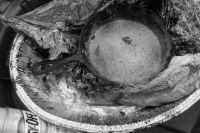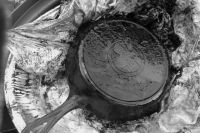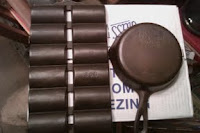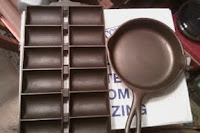Stripping & Cleaning
There are a number of methods by which you can successfully clean old build-up from cast iron pans. Presented here are those deemed reliable and non-destructive of collectible value by the collecting community.
| Basic:
» Aerosol Oven Cleaner » Vinegar Bath |
Advanced:
» Lye Bath » Electrolysis » Molasses Soak » Finishing Touches |
More:
» Cleaning Caveats » Summary » Other Thoughts » Examples |
Aerosol Oven Cleaner Spray
A very simple method for stripping old seasoning off a cast iron piece is to coat it with oven cleaner spray. Most regular oven cleaner spray is lye-based. Look for lye's chemical name, sodium hydroxide, as the active ingredient. Of the available brands, Easy Off Heavy Duty™ seems to work best, because its thick, foamy consistency coats and sticks better than cheaper store brands. Cleaners that tout reduced odor typically use active ingredients other than lye, so don't use them. Do this procedure in a well-ventilated area outdoors, and use eye and skin protection.
To prevent the spray foam from evaporating and drying up, wrap the piece up in a plastic trash bag, and place it in a warm spot, away from the reach of children and pets. To protect against leakage, place the bagged piece in something like an old plastic dishpan or a large disposable roasting pan (bearing in mind that, over several uses and leaking bags, the lye can eat the aluminum somewhat).
It will take several days for the oven cleaner to work its magic. Check back in a day or so, and reapply cleaner as necessary until all the crud is softened into a brownish-black goo that can be rinsed off.
As a long term cleaning solution, aerosol oven cleaner is relatively expensive. If you will be cleaning more pans in the future or want to clean several pans at a time, a lye bath is easier and more cost effective.
Aerosol oven cleaner at work:
Basic Rust Removal: Vinegar Bath
Surface rust can often be removed using a simple solution of one part white vinegar and one part water. Soak the piece for 30 minutes in a container large enough to treat the entire pan at once. If not completely submerged in the vinegar solution, the result will be an unevenness of color. Then scrub using a stainless steel scouring pad or steel wool, and rinse well.
Additional half hour soaks/scrub sessions may be necessary and are OK, but don't leave the piece soaking for longer periods; the acidity can compromise and erode good iron if left too long.
Never leave a piece in the vinegar solution for longer than 30 minutes.
Don't spend extra money on apple cider or name brand vinegar-- any cheap store brand white vinegar will do.
Once free of rust, to prevent its return, the piece should be thoroughly rinsed, dried, and seasoned.
Note: You may have heard or read elsewhere of using the cut face of half a potato and salt or baking soda to remove rust from cast iron. Some sources even go so far as to "science it up" by claiming the oxalic acid found in potatoes has some magical rust removing properties. Oxalic acid is found mainly in leafy green vegetables, parsley and spinach being among the highest, with potatoes containing roughly 20-35 times less of it by equivalent weight. Do yourself a favor and don't waste a perfectly good potato.
(If you're not interested in setting up a lye bath or an electrolysis tank, you can now skip ahead to Initial Seasoning.)
Lye Bath
Like oven cleaner spray, lye works great at removing crud from cast iron without harming it. Setting up a lye bath involves mixing a solution of lye and water of an appropriate strength in a suitable container capable of submerging one or more pieces of cast iron cookware to be cleaned. As with any caustic chemical, safety precautions must be observed.
Learn more about using lye to clean cast iron.
Electrolysis
Among the variety of restoration tools available to the dedicated vintage cast iron cookware collector, perhaps the most useful of all is cleaning by electrolysis. While a bit more work and expense than other methods to set up, a properly designed and implemented electrolysis tank can remove both rust and build-up in relatively short order, and can clean many pans before requiring refurbishment.
Learn more about using electrolysis to clean cast iron.
Molasses Soak
For those who want a less hands-on method of rust removal, there is an alternative, using molasses. This method is popular in the restoration of iron automotive and machine parts because of its effectiveness, its labor un-intensiveness, and its ability to convert rust deep inside castings with cavities where other cleaning methods would be difficult.
The formula for a molasses soak is a 10% solution of molasses and water, i.e. 1 part molasses to 9 parts water. The molasses used for an animal feed supplement in liquid form is the type you want, so check a local farm supply store for it.
Molasses takes from 2 to 4 weeks for a piece with average surface rust. As with lye for crud removal, submerge the piece completely. During this time, fermentation will naturally occur, so be aware that moving a piece in the soak may cause a sudden release of trapped pockets of gasses causing splashing. You can avoid this by submerging pieces in an upright position.
Like lye on carbonized grease build-up, molasses works better and faster at a warmer temperature. Since the process relies on a biological reaction, you don't want it hotter than about 105°. This biological process also results in the formation of mold and a scum on the surface of the solution, as well as a distinct odor. You therefore want to do a molasses soak outside, in a covered-but-not-airtight container.
Check the container regularly to gauge the progress, and to make sure it hasn't sprung a leak. Should the solution leak out and leave the piece to dry out with a coating of the solution on it may result in damage.
Once complete, the rust should be gone, but a coating of molasses scum may remain. Use a scrubber pad and hot water to remove it before any necessary final touch-ups and proceeding with your initial seasoning regimen.
Finishing Touches
Finally, you go to the hand tools. I use a variety of things for the finishing touches before seasoning, and only those that will not mar the iron.
Items I find useful include:
- Stainless steel Chore Boy™ scrubbers (never brass or copper, they will transfer their color to the iron)
- A medium stiffness stainless steel bristled brush
- Popsicle sticks and expired credit/gift cards cut into shapes are great for getting into crannies to scrape and chip away at stubborn bits
- Bamboo skewers work well for deep cleaning loosened crud from skillet markings or from fine details in pieces like corn stick pans
- 0000 steel wool for a final once-over on smooth surfaces
Sometimes, on pans that have extensive long term build-up, there will be areas that defy removal by either lye or electrolysis, leaving stubborn "warts" of tightly stuck-on carbonized material. Often, a good scrubbing with a Stainless Steel Chore Boy will remove them.
Another option is to carefully scrape them off with a putty knife. A 1" wide blade works best. File the corners of the blade round first so as not to risk scratching the iron. Keep the leading edge of the knife flat against the iron, working horizontally on curved sidewalls. Don't try to take the "wart" off all at once; instead concentrate on keeping the blade edge flat to the iron and work slowly through it. Use this technique on polish ground surfaces only. For as-cast surfaces, stick with the Chore Boy.
There will often be some dark stains left behind, either from spots where rust was once active or from a stubborn carbon wart, and that's not unusual. Again, don't use anything harsh to try to remove them or you risk damaging metal. And by damage, I mean the leaving of any kind of marks, either scraping, grinding, or even polishing swirl marks. The consensus among collectors, though, is it's normal to have some staining and cooking utensil marks on vintage cast iron because people didn't buy pans back-when to display, they bought them to use. You can try to remove or at least minimize residual stains by soaking the piece in a solution of 50/50 white vinegar and water for 30 minutes at a time, followed by a buffing with 0000 steel wool. Rinse thoroughly with plain water to neutralize the vinegar solution.
Never leave a piece in the vinegar solution for longer than 30 minutes.
An alternate method is to wet the piece and then apply white vinegar full strength with a sprayer bottle. Let stand a few minutes and scrub with a stainless steel scrubber or steel wool, again followed by a thorough rinsing.
Never leave a piece with full strength vinegar on it for longer than a few minutes.
With repeated cooking use, however, layers of new seasoning will continue to darken the piece, and any stains that did not yield to the vinegar treatment will blend in.
Cleaning Caveats
As you delve more into the subject, you'll likely hear or read about various other "quick and easy" methods for cleaning cast iron. From a collector's standpoint, anything that even subtly alters the original appearance of the metal is to be strictly avoided, as it will seriously impact value. This means no screwdrivers, chisels, ice picks, or any of the following.
Cleaning pieces by burning them in a fire, or using a self-cleaning oven both have the potential to ruin if not outright destroy a piece.
Fire may heat the iron to the point it alters the molecular structure of the iron, turning the metal surface scaly and an irreversible, rosy red color. Pieces so-damaged will never season properly again.
Even though a piece is allowed to heat and cool very slowly in a self-cleaning oven, overheating some pieces may still induce warping or cracking. On many pans, it may work just fine, but, since self-cleaning ovens can vary in their working temperatures by hundreds of degrees, there still exists a chance of damage, especially with older thin-walled pans. The prudent advice is don't try it unless you can afford to replace the piece if something should go awry.
Enameled pieces should not be attempted to be cleaned in a SCO.
If they cannot be removed without damage, also note that wood handles will not survive SCO temperatures, and steel wire coil or bail handles may potentially lose their tempering and become malleable.
Other downsides to SCO cookware cleaning include increased electricity usage, odor, kitchen heating, and oven wear & tear. The performance and appearance of oven racks can also be affected by running them through a SCO cycle; removing them requires devising a heat-proof way to support pieces above the heating element.
The use of power tools also risks leaving permanent grinding marks or swirls in the metal. Sand or bead blasting will also slightly but permanently alter the original surface texture.
Although Scotch-Brite pads seem like an ideal scrubbing implement, one must be aware that there are several different grades of abrasiveness. Some of the more aggressive versions are impregnated with aluminum oxide, which has the potential to detrimentally change the original surface patina of your collectible cast iron. You should therefore proceed with caution before purchasing and using this product.
You may see methods demonstrated in youtube videos which purport to be the best way to clean your cast iron pans. Bear in mind that these days just about anyone with a smartphone and a youtube account can make and upload a video. Those with better equipment and skills-- and aspirations of internet stardom, apparently-- can produce very slick video presentations, but not always with particularly solid information.
Many youtube videographers are actually earning money by publishing content-- lots of content. Their goal is to publish as many videos as possible and have those videos seen by as many viewers as possible, and not necessarily to disseminate helpful, accurate, or collector approved information.
Always seek a second opinion on any cast iron cleaning or seasoning youtube video.
Summary
Which is better, lye or electrolysis?
Lye (and lye-based oven cleaner) melts the crud in to a black goo that rinses off. Electro makes the crud release from the metal. Both still require a little elbow grease afterwards.
The lye tank is a real workhorse, since you can throw multiple pieces in it and forget them for a week (or more). The electro removes the rust lye can't, but you can also use a simple white vinegar solution to remove rust.
Some people use electro exclusively, because they think lye is not good to use on an item you will be cooking food in, or that it will damage the metal. I have to date not found any reliable information to support either of those concerns. After proper cleaning and rinsing, no lye residue remains.
The best results actually come from using both lye and electrolysis. First, because lye won't affect rust, and second, because lye can do most of the hard work unattended, letting the electrolysis more quickly and easily handle what it does best.
Bottom line: You can be successful using either lye or electrolysis. Or both.
Other Thoughts
If, at some point, your immersion in the hobby causes you a regular supply of iron to clean, there are a couple of other items you may want to investigate.
Occasionally, vestiges of removed rust will persist in the form of black stains which no amount of vinegar or elbow grease will seem to totally erase. Relief may be possible in the form of a product called Evapo-Rust®. It's a bit pricey at around $25 per gallon, but, when necessary, and used sparingly, it is reported to work wonders on those troublesome spots. A proprietary formula-- said to contain a common chelating agent-- apparently non-acid, non-toxic, and can be safely disposed of down household drains. Only rust is dissolved by it, leaving good metal intact. It should not be used, however, to de-rust painted surfaces, as they may be adversely affected.
For those threaded handles on waffle irons that you'd really like to remove, but feel like they'll break before they budge, even with WD-40, there's another product receiving good reviews called Kroil®. A penetrating oil, it's said to make quick work of those long-frozen handles. You may have to look a bit to find it locally, but it is available from Amazon.
Examples
Two pieces that were cleaned using a combination of lye and electrolysis. Residual black stains on the inside of the small skillet were reduced using the vinegar/water solution.
And here's what was a rusty Lodge #7, after electrolysis alone.














